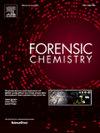Analysis of substituted Cathinones and fentanyl analogs by gas chromatography-infrared spectroscopy (GC-IRD) using nitrogen carrier gas
IF 2.6
3区 医学
Q2 CHEMISTRY, ANALYTICAL
引用次数: 0
Abstract
Substituted cathinones and fentanyl analogs that are positional isomers can produce similar mass spectra and retention times, which poses challenges for their identification. A gas chromatography-infrared spectroscopy (GC-IRD) method, developed using nitrogen as the carrier gas, was employed as a complimentary technique to gas chromatography-mass spectroscopy (GC–MS) for the accurate identification of positional isomers. Due to the global helium shortage and since Agilent helium (nitrogen switch) conservation modules were currently in use, nitrogen was selected and a novel method was developed for the analysis of controlled substances. A total method run time of 26 min for the analysis of 29 certified reference materials comprised of substituted cathinones and fentanyl analogs was achieved. A drug mixture was also analyzed to evaluate the resolution and retention time. Standards were prepared at concentrations of 100 μg/mL, 1 mg/mL and 2 mg/mL and analyzed over a 3-day period, where the 2 mg/mL concentrations of the standards were run in triplicate on day 1 and once on days 2 and 3. Twenty-seven of the standards were identified with a library match of 0.98 or higher for the 1 mg/mL concentration. Each standard experienced a retention time (RT) coefficient of variation (%CV) less than 3 %. For the drug mixture peak resolution exceeded 1.5 for each component. The GC-IRD validated method was found to be a suitable complementary analysis technique to GC–MS for analyzing substituted cathinones and fentanyl analogs, as demonstrated by the repeatable and reproducible RTs and library matches obtained during method validation.

氮载气气相色谱-红外光谱法分析取代卡西酮和芬太尼类似物
取代卡西酮和芬太尼类似物是位置异构体,它们可以产生相似的质谱和保留时间,这给它们的鉴定带来了挑战。建立了以氮气为载气的气相色谱-红外光谱(GC-IRD)方法,作为气相色谱-质谱(GC-MS)的补充技术,用于准确鉴定位置异构体。由于全球氦气短缺,并且目前正在使用安捷伦氦气(氮气开关)保护模块,因此选择了氮气,并开发了一种分析受控物质的新方法。对由取代卡西酮和芬太尼类似物组成的29种标准物质进行分析,总运行时间为26 min。还分析了药物混合物,以评估分辨率和保留时间。制备浓度为100 μg/mL、1 mg/mL和2 mg/mL的标准品,分析3天,其中2 mg/mL浓度的标准品在第1天重复三次,第2天和第3天重复一次。27个标准品的库匹配度为0.98或更高,浓度为1 mg/mL。每种标准品的保留时间(RT)变异系数(%CV)均小于3%。各组分的峰分辨率均超过1.5。GC-IRD验证方法是一种适合于GC-MS分析取代卡西酮和芬太尼类似物的补充分析技术,方法验证过程中获得的可重复和可重复的rt和文库匹配证明了这一点。
本文章由计算机程序翻译,如有差异,请以英文原文为准。
求助全文
约1分钟内获得全文
求助全文
来源期刊

Forensic Chemistry
CHEMISTRY, ANALYTICAL-
CiteScore
5.70
自引率
14.80%
发文量
65
审稿时长
46 days
期刊介绍:
Forensic Chemistry publishes high quality manuscripts focusing on the theory, research and application of any chemical science to forensic analysis. The scope of the journal includes fundamental advancements that result in a better understanding of the evidentiary significance derived from the physical and chemical analysis of materials. The scope of Forensic Chemistry will also include the application and or development of any molecular and atomic spectrochemical technique, electrochemical techniques, sensors, surface characterization techniques, mass spectrometry, nuclear magnetic resonance, chemometrics and statistics, and separation sciences (e.g. chromatography) that provide insight into the forensic analysis of materials. Evidential topics of interest to the journal include, but are not limited to, fingerprint analysis, drug analysis, ignitable liquid residue analysis, explosives detection and analysis, the characterization and comparison of trace evidence (glass, fibers, paints and polymers, tapes, soils and other materials), ink and paper analysis, gunshot residue analysis, synthetic pathways for drugs, toxicology and the analysis and chemistry associated with the components of fingermarks. The journal is particularly interested in receiving manuscripts that report advances in the forensic interpretation of chemical evidence. Technology Readiness Level: When submitting an article to Forensic Chemistry, all authors will be asked to self-assign a Technology Readiness Level (TRL) to their article. The purpose of the TRL system is to help readers understand the level of maturity of an idea or method, to help track the evolution of readiness of a given technique or method, and to help filter published articles by the expected ease of implementation in an operation setting within a crime lab.
 求助内容:
求助内容: 应助结果提醒方式:
应助结果提醒方式:


